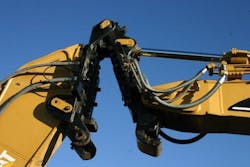A couple weeks ago, we encountered an interesting product and an interesting man behind the product. The product is the Gilmore TOOL LINK® coupler, and the man behind the product is Charles “Charlie” Gilmore.
Charlie Gilmore, an entrepreneur through and through, has devoted a number of years to developing and refining an innovative quick-coupler system for hydraulic excavators. Instead of mounting to the end of the stick as do conventional couplers, the male half of the Gilmore TOOL LINK® coupler mounts to the tip of the boom, and the female half mounts to either a boom-mounted work tool or to a stick with an attached work tool. The male half is pinned to the boom, and the female half either can be pinned or welded to the work tool or stick.
A competent operator can bring the two coupler halves together in about 30 seconds, says Gilmore. The male half has a "picker" end and a "grabber" end, either of which the operator can use to initially engage the female half, depending on the orientation of the work tool or stick. Once the two halves of the coupler come together, a latch on the end prevents their separation, and a positive locking system makes the connection secure by driving a wedge pin into both ends of the female half.
Each wedge pin is turned into position by a drive shaft that is hydraulically powered through a double-reduction, planetary gear set. A spring-applied/hydraulically released brake, similar to that used in an excavator’s track motors, ensures that the two wedge pins remain in place and can’t loosen at any time while the two halves are coupled together.
As the two halves come together, patented quick-connect/disconnect fittings ("Zero Slack Instantaneous Power Source QCs") engage to provide instant power to the work tool. "Power" can include not only hydraulic, but also electrical, pneumatic, vacuum and grease (for, say, automatically lubricating a large hammer), and up to 10 such connections are available through the coupler.
The operator can closely observe the entire picker connection, which at times can be difficult, says Gilmore, via an in-cab monitor that's linked to an infrared camera system—infrared to assist with nighttime tool switches. The camera eliminates the need for a spotter, says Gilmore.
With the TOOL LINK® coupler system, every boom-mounted work tool requires its own female coupler half, as does every stick that has a work tool pinned at its bucket end.
That requirement sounds expensive, says Gilmore, until considering that a contractor who regularly switches between a conventional stick and a large boom-mounted work tool might spend six to eight hours at the task, assuming no problems are encountered, and could incur costs as high $10,000.
Included in the cost of a typical switch can be numerous mechanics, operators and laborers; a well-equipped mechanics truck with a sizeable crane; an aerial lift platform (with all required operator-safety hardware); a small wheel loader or skid-steer loader to assist with stubborn pivot pins; and an assortment of tools.
All the while, says Gilmore, people making the switch are placed in harm's way, exposed to potential dangers that include working overhead, slipping on hydraulic oil that's typically sloshing everywhere, as well as high-pressure-hydraulic-injection injuries. In addition, he says, OSHA requires that the machine be properly locked-out/tagged-out as it sits, unproductive, for the better part of a day.
The tool could be left on the boom, says Gilmore, but then the machine becomes a single-purpose unit with lowered utilization; the TOOL LINK® coupler system, he says, promotes machine utilization. For instance, a demolition contractor using the coupler on a large excavator could easily switch among various work tools several times per day—perhaps a hammer, shear, magnet, multi-processor and crusher.
In addition, says Gilmore, the coupler promotes stick/work-tool compatibility, in that it assures that the two components are optimally matched for efficient operation, reduced stress and, ultimately, longer life for both. And for any contractor, the ability to quickly drop the stick is an effective means for reducing the excavator's transport height, which can simply the logistics of moving machines.
TOOL LINK® couplers eventually will be available in seven sizes to fit most major brands of excavators with operating weights from 20 to 99 tons. At present, the system is available for the seven largest models in Caterpillar’s excavator range.
And if you're interested, Gilmore Inc. also has developed a trench box that hydraulically expands in width after it's positioned in the trench—from 7 to 21 feet. The patent-pending MERT™ (Mechanized-Expandable-Retractable-Trench Box) is a boom-mounted tool using the TOOL LINK® coupler system. MERT™ trench boxes are available in lengths from 30 to approaching 50 feet.
Charlie Gilmore admits that most people are skeptics when they first hear about the TOOL LINK® coupler system. But talk to Charlie for an hour and take in his presentation, which shows the coupler in action, and you might come away a believer.
"The system isn't for everyone," says Charlie, "but it makes a lot of sense for those who could benefit from its capabilities."




